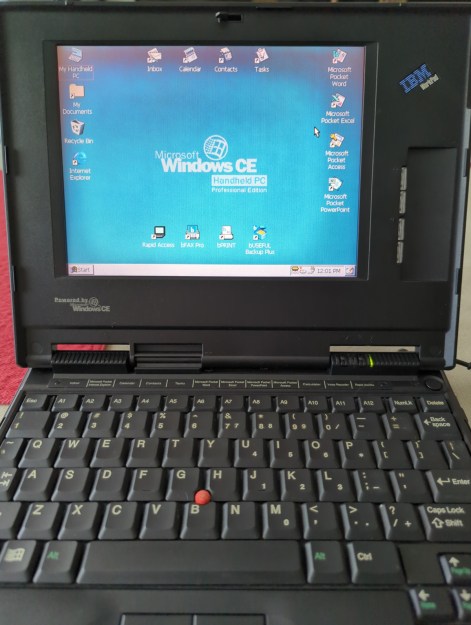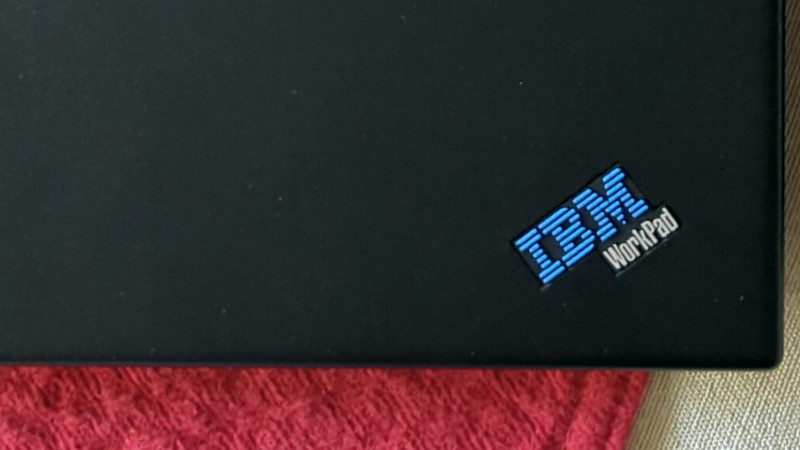We’re used to our laptop computers here in 2022 being ultra-portable, super-powerful, and with impressively long battery lives. It’s easy to forget then that there was a time when from those three features the laptop user could usually expect only one of them in their device. Powerful laptops were the size of paving slabs and had battery lives measured in minutes, while anything small usually had disappointing performance or yet again a minuscule power budget.
In the late 1990s manufacturers saw a way out of this in Microsoft’s Windows CE, which would run on modest hardware without drinking power. Several devices made it to market, among them one from IBM which [OldVCR] has taken a look at. It makes for an interesting trip down one of those dead-end side roads in computing history.
 In the box bought through an online auction is a tiny laptop that screams IBM, we’d identify it as a ThinkPad immediately if it wasn’t for that brand being absent. This is an IBM WorkPad, a baby sibling of the ThinkPad line intended as a companion device. This one has a reduced spec screen and an NEC MIPS processor, with Windows CE on a ROM SODIMM accessible through a cover on the underside. For us in 2022 MIPS processors based on the open-sourced MIPS ISA are found in low-end webcams and routers, but back then it was a real contender. The article goes into some detail on the various families of chips from that time, which is worth a read in itself.
In the box bought through an online auction is a tiny laptop that screams IBM, we’d identify it as a ThinkPad immediately if it wasn’t for that brand being absent. This is an IBM WorkPad, a baby sibling of the ThinkPad line intended as a companion device. This one has a reduced spec screen and an NEC MIPS processor, with Windows CE on a ROM SODIMM accessible through a cover on the underside. For us in 2022 MIPS processors based on the open-sourced MIPS ISA are found in low-end webcams and routers, but back then it was a real contender. The article goes into some detail on the various families of chips from that time, which is worth a read in itself.
We remember these laptops, and while the IBM one was unaffordable there was a COMPAQ competitor which did seem tempting for on-the-road work. They failed to make an impact due to being marketed as a high-end executive’s toy rather than a mass-market computer, and they were seen off as “real” laptops became more affordable. A second-hand HP Omnibook 800 did the ultra-portable job on this bench instead.
The industry had various attempts at cracking this market, most notably with the netbooks which appeared a few years after the WorkPad was produced. It was left to Google to reinvent the ultra-portable non-Intel laptop as an internet appliance with their Chromebooks before they would become a mass-market device, but the WorkPad remains a tantalizing glimpse of what might have been.
Windows CE occasionally makes an appearance here, and yes, it runs DOOM.
















nice oddball, there :)
I have a Laptop with a microSPARC CPU. Another oddball :)
Tadpole?
yes
I also have an oddball laptop with a DEC Alpha CPU. Both a tadpole version and a DEC version. Runs VMS, digital Unix, or Windows NT.
I’ve got an old satnav that runs windows ce. It was amusing to discover, after removing the stock mapping software, everything wasn’t stripped down. There was the xp like desktop, taskbar, start menu, even mine sweeper, solitaire and aa copy of internet explorer. I never did get around to hacking it fully. No doubt there’s some potential in devices like that, especially if USB peripherals could be added.
Very neat. Ever WinCE 5 GPS I’ve seen has had the OS stripped to the point of uselessness, except for being able to redirect to run different navigation software than what came on it, either from an SD card or from internal storage.
My first was a RightWay RW200. While poking around in it I found how to bypass the rather poor nav software and get into WinCE, which was all in Chinese. I poked the wrong thing and deleted the nav software. Oops. Then I figured out how to install iGO in the internal storage.
I was attempting to locate the built in video player software to see if I could copy it to another WinCE 5 GPS but it and the other apps launchable from the menu are super hidden, invisible to the WinCE file explorer. Deleting the original nav software didn’t touch those apps or the menu.
With other WinCE GPS units it’s been easy to change to iGO simply by using an option in the menu to point to the executable on the SD card instead of internal storage.
I wish modern laptop designers would take a lesson from those cursor keys: full-sized and spaced apart from other keys.
I know laptop design is all about compromise particularly regarding space, but half-height keys squashed in with other keys drive me up the wall, a complete concentration breaker when you go for a simple left-arrow and get some other key instead.
IBM of old knew about keyboards.
Sometimes I get the feeling that laptop and phone design work like fast food interior design – Make the user just uncomfortable enough to move on quickly.
Sounds like you’re buying netbooks that are trying to fit in a small form factor. If you get a laptop that’s built for performance instead of carrying, this isn’t usually a problem.
I use an Asus ROG Strix laptop because my requirements were an i7 CPU, a discrete GPU with CUDA, and a keyboard with a full numpad. Asus’ lapcrushers fit the bill nicely and happened to be the cheapest option at the time. It even has non-squashed arrow keys.
Low profile, but non chiclet style keycaps, too. Love those.
Some would call me a heretic, but I *Like* having the ability to put custom decals on the front of keycaps.
Which means either having an external keyboard, or using one of these older style devices.
Where can I get my hands on the open source part of mips?
I guess that author is confused by two facts. First, MIPS is often used as an example architecture on universities, and everyone (who knows something about CPU architectures) is familiar with it. And second, in 2018. it was announced that MIPS ISA will be open-sourced, but it never did.
According to Wikipedia it did open up one version for about six months in 2019 – before the whole MIPS Open program was abruptly mothballed.
How did that work? How does one retract an open source license?
I was wondering the same, so I did a little search. I found following article: https://lwn.net/Articles/747563/
Focus is on US, UK and EU jurisdictions, and conclusion is that open source license is irrevocable.
https://en.wikipedia.org/wiki/MIPS_Technologies
There are some open source MIPS implementations based on expired patents. See BERI for example.
I had a great time with one of those for a while. WinCE served as a tolerable bootloader for NetBSD on a CF card. A PCMCIA WiFi card dragged it into the age of ubiquitous internet, though 48 MB of RAM and an anemic, FPU-less CPU did not make for fast browsing unless you disabled images.
Not specifically called out there, if when you think Netbook, you think x86 Atom or maybe Via Eden etc. are the MIPs powered bottom of the barrel netbooks that came to be referred to as “Little Linux Laptops”. Known brands or models were: Trendtac 700 EPC, Elonex One T, Maplin Minibook, 3k Razorbook, 3nM minibook, CnM Lifestyle minibook , Bestlink Alpha 400. A lot of the info about how to repair, replace and upgrade the dumbed down linux installs on them has succumbed to webrot though. Don’t get too excited, the screens were only around 800×400, the keyboard and touchpad cheap, and 400Mhz of MIPS doesn’t set the world ablaze.
I’ve got one that was even less common than any of those ones and was close enough to give me hope but different enough none of the known tricks work on it, been stuck in a bootloop I can’t break since I got it. If my September hadn’t turned out all screwed up, bits of it might have been reincarnated as a cyberdeck.
I have an Eken tablet version of those kicking around. Last time someone coughed the laptop style up we found a nicely functional (if circa 2004) Debian(?) OS that still worked on it,
In my drawer lies an even smaller WorkPad, aka Palm:
https://en.wikipedia.org/wiki/IBM_WorkPad
Me too!
“International Business Machines Workpad” is possibly the most no fun allowed name ever
I remember these things. Windows CE 2.11, 3.0.. Pocket PC 2000, Windows Mobile 2002, Windows Mobile 2000, Windows Mobile 5, Windows Mobile 6..
It’s important that there were different device classes (palmtops, handhelds, GSM phones etc) and that Windows CE was the basis for all of them.
Pocket PC 2000 was using Windows CE 3 and supported MIPS, SH3 and ARM. Later on, ARM became the defacto standard. There was StrongARM, XScale etc.
On both PDAs and handhelds, GAPI (Game API) was an important third-party component (optional).
Windows Mobile 5 (PDAs) was the last version to be quite compatible to old applications, afaik.
Same for the handhelds/laptops. CE 6 broke compatibility with older applications, including GAPI.
Neko Project, an PC98 emulator, had binaries for WinCE for a while (both PDA and handheld).
wonderful times back then, WinCE was a cool playground. Cooking Roms, Installing ScummVM, later unlocked XDAs via Registry.
Recently I stepped over WinCE in the wild, when i “accidently” messed around with the Display of a self propelled mower
https://www.teltarif.de/allfine-pc703-unboxing-netbook-fur-99-euro-kaufhof/news/x11958.html
these were a thing in germany around 2010, they were cheaper than netbooks, but in generell you were better grabbing a via-based netbook like this https://www.ebay.de/itm/403667933052? they even came with a real 60GB-Harddrive and windows drivers or Linux running on them and were more powerfull and flexible than the eeepc.